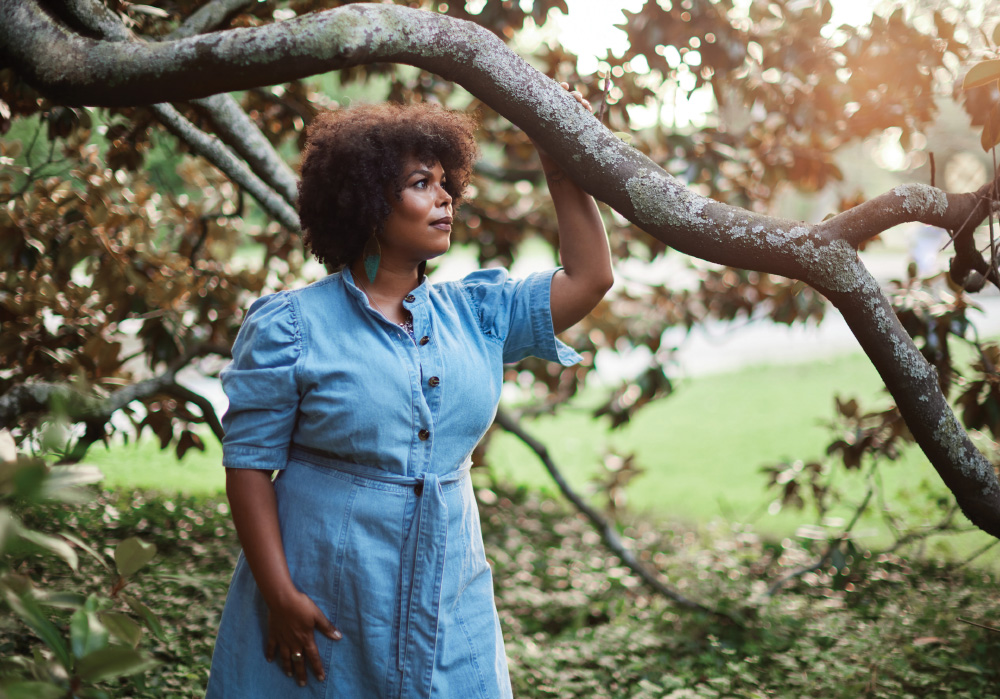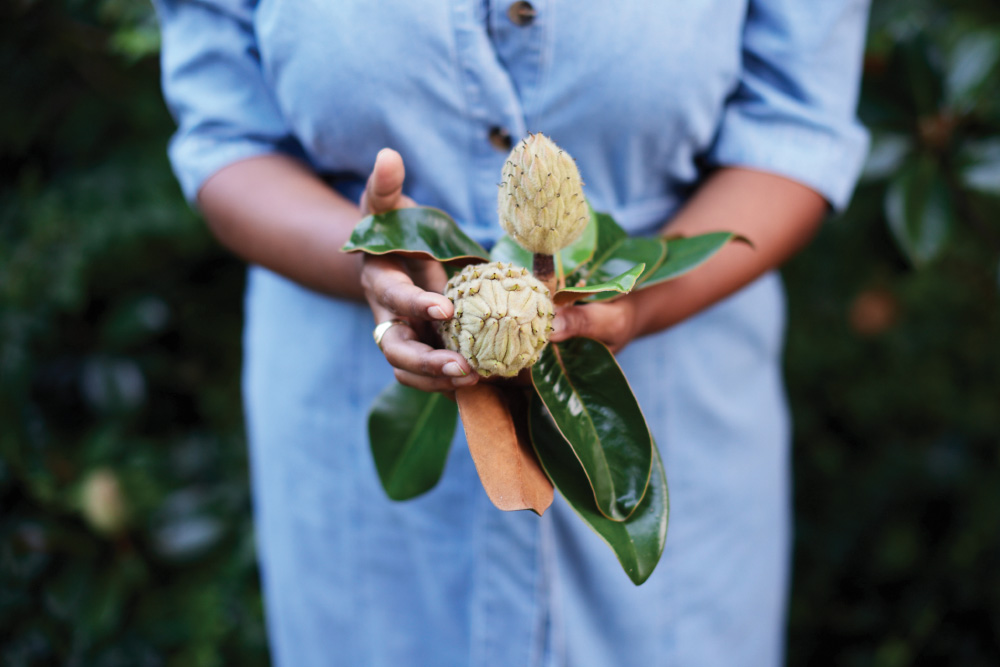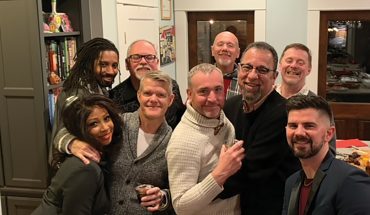The folklorist, writer, and director of the North Carolina Division of State Historic Sites shares what sparked her interest in preserving the past.
by Ilina Ewen | photography by Samantha Everette
From verdant shores along the Carolina coast, nature — equal parts play ground, classroom, and inspiration — has shaped Michelle Lanier into who she is today. What has the land witnessed?
A folklorist, documentarian, writer, and teacher, as well as the director of the North Carolina Division of State Historic Sites, Lanier has asked herself this question dozens of times. “When we pause and reflect on what happened in a place, it leads to other questions: what stories have been untold or under-told?” she says. For Lanier, the land and its people exist as an intricate and everchanging series of connections and webs.
Lanier grew up in South Carolina, and spent part of her childhood on Hilton Head Island among Gullah traditions. “As a young child, I’d spend my days look- ing out on landscapes and waterways, seeing snakes, alligators, horseshoe crabs, and jellyfish; climbing trees and watch- ing birds fly,” she says. “I felt the land somehow mirrored me.”
She considered her grandmother’s home in Columbia, a brick Georgian on a block lined with stately magnolia trees, to be her oasis. “These trees stood watch as our ancestors journeyed to and through the South,” she says. “They are our kin.” Lanier was raised in a multi-generational household, one where she learned from her elders and aunties alike. She hails from a long line of educated family; her mother earned a PhD at a time when few women, especially women of color, were doing so.
Her mother also gifted her a love of books and made young Lanier feel affirmed and empowered, ensuring she knew “that there were examples of bravery and brilliance and beauty that ran counter to many of the stereotypes I saw in pop culture or heard about in my school.” Lanier lost her mother to suicide when she was just 10 years old, shaping her outlook on memory, traditions, and community. It was also around this time that she had her first sense of being part of the African diaspora.
“I’d hear about ‘family across the sea’ and stand on the shores of Daufuskie Island, wondering if there was someone related to me looking back,” Lanier says. “It was a clarion call in my heart – I remember thinking, I need to remember this, and I need to do something about it.”
She graduated from Spelman College and completed graduate studies in folklore at the University of North Carolina at Chapel Hill. And that awakening inspired extensive genealogical research on her own family, finding connections across the state — reaching back to the 1700s, from the coastal plain to the sandhills and northern Piedmont — and into South Carolina. “Afro Carolina is my chosen moniker for my cultural background, and for me, that means both place and people,” says Lanier.
She explored the idea in a recent article in Southern Cultures magazine, where, through a concept she calls “womanist cartography,” she explores how gender shapes Southern women of color’s experience with the world. “Every story my grandmother shared was a map and a monument,” she writes, as she examines routes of migration, geographical areas women occupy, and how traditions are passed down, to ask the question, How do we remap certain spaces to center the memories?
Lanier has taught for 20 years at the Duke Center for Documentary Studies, including courses in oral histories and the popular Intro to Documentary Studies class. One former student, Melanie Allen, co-director of The Hive Fund for Climate and Gender Justice, says Lanier helped propel her to a career in storytelling and documenting ancestral roots. “She showed me the power of documentary studies, and I was inspired by her ethos as witness to work to amplify stories of our ancestors while preserving dignity of the people,” says Allen.
Lanier is a filmmaker and producer of films like Mossville, which is about environmental justice within a Louisiana town. Fellow filmmaker and North Carolina State University assistant teaching professor Natalie Bullock Brown has known Lanier for close to a decade. She sees her as an inspiration for bringing unapologetic authenticity, wisdom, and power to each project. “She treats land like it’s sacred because it is,” says Brown. “Michelle understands how our stories shape us — you have to know who you are and what your purpose is.”
In 2018, Lanier was chosen to lead the Division of State Historic Sites. Along with a team of historians, archivists, and volunteers, she makes places come alive, not just through markers and plaques, but with immersive storytelling, programming, and events. She’s the first Black woman in this role, one that requires her to be both introspective and globally minded as she considers how to reach people and draw out their own stories: “How can I connect my calling — being a keeper of memory for myself and my communities — to the people I welcome into these spaces?” she asks.

Her tenure comes at a time when society is grappling with how to earnestly and honestly frame narratives around historic sites, particularly ones with Indigenous and Confederate-era significance. One example is Historic Stagville in Durham County: owned by the Bennehan-Cameron family, this was one of the largest plantations in the South, and the slave quarters and family home still stand. Today, visitors learn about the experiences of the hundreds of enslaved workers who labored here — not just a glorified version of the life of the land owner. She believes this painful past is worth confronting. “I see it as a kind of pilgrimage to pay my respects at spaces of human bondage,” says Lanier. “It is a powerful act because I stand on that soil free and self-determined and autonomous. I appreciate the opportunity to be silent, to grieve, to be reflective.”
A lover of primary resources, Lanier spends hours poring through Southern historical collections among the trove of resources at UNC and the Duke University Rubenstein Rare Book and Manuscript Library. She also takes inspiration from women like UNC geography professor Danielle Purifoy and Brooklyn-based painter Torkwase Dyson, who each express historic narratives through storytelling, art, and placemaking. “These women inspired me to be thinking about the ways in which I’m digging into concepts around memory and land and space,” Lanier says, citing their focus on the spaces we occupy, environmental justice, and how we navigate both natural and manufactured spaces.
“Michelle is a cultural and experiential omnivore,” says documentary artist and Duke colleague Courtney Reid-Eaton. “She has a path with many lanes, and she loves her people and wants us to love ourselves.”
Throughout every facet of her work, Lanier has found that learning about where one comes from can shape how we interact with the world around us today. “It’s powerful to look at how our cultural identities, land, and ancestry can all dance together,” says Lanier. “It creates a new portal of understanding.”
This article originally appeared in the November, 2021 issue of WALTER Magazine.





